The Web Index Assignment
VerifiedAdded on 2020/05/01
|20
|3419
|48
AI Summary
Contribute Materials
Your contribution can guide someone’s learning journey. Share your
documents today.
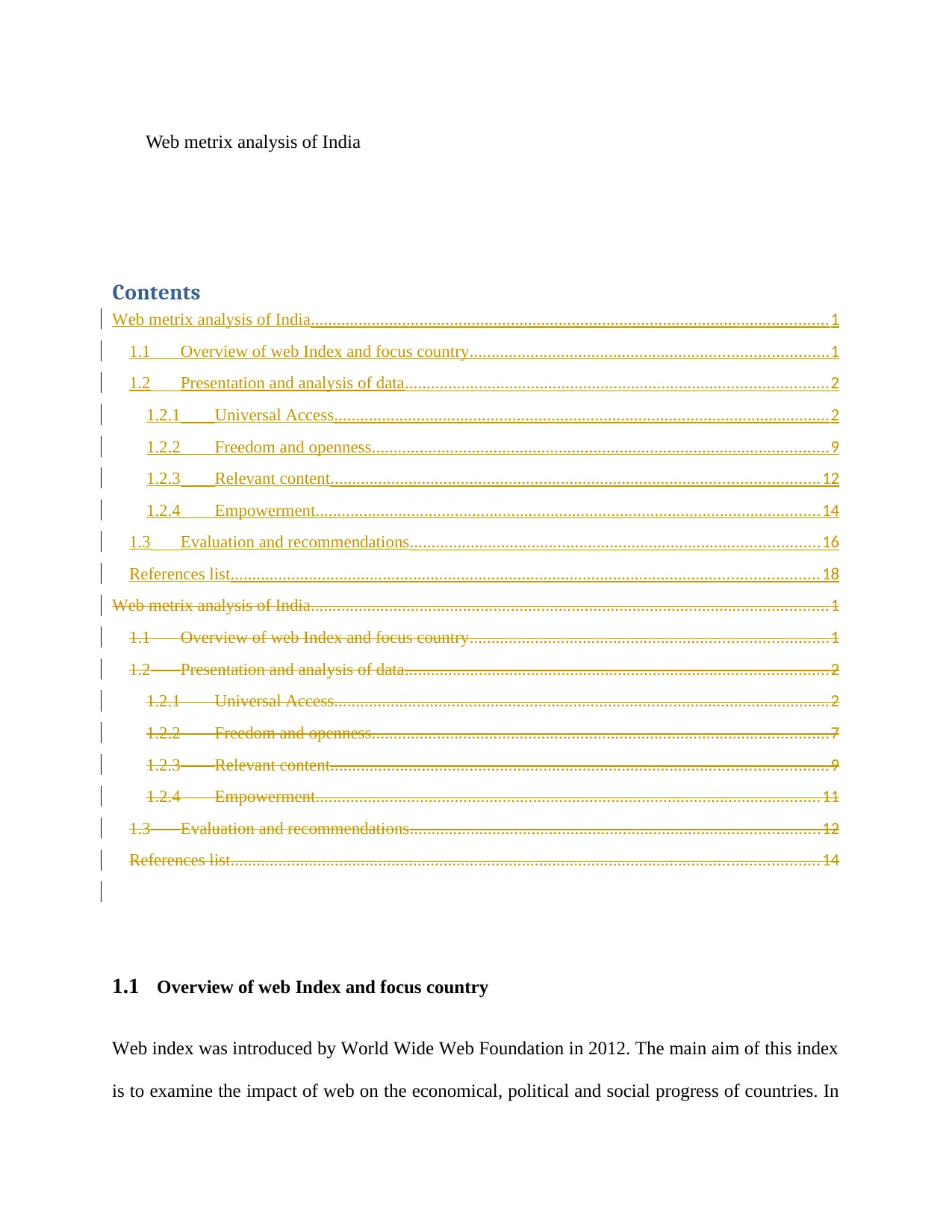
Web metrix analysis of India
Contents
Web metrix analysis of India.......................................................................................................................1
1.1 Overview of web Index and focus country..................................................................................1
1.2 Presentation and analysis of data.................................................................................................2
1.2.1 Universal Access..................................................................................................................2
1.2.2 Freedom and openness.........................................................................................................9
1.2.3 Relevant content................................................................................................................12
1.2.4 Empowerment....................................................................................................................14
1.3 Evaluation and recommendations..............................................................................................16
References list.......................................................................................................................................18
Web metrix analysis of India.......................................................................................................................1
1.1 Overview of web Index and focus country..................................................................................1
1.2 Presentation and analysis of data.................................................................................................2
1.2.1 Universal Access..................................................................................................................2
1.2.2 Freedom and openness.........................................................................................................7
1.2.3 Relevant content..................................................................................................................9
1.2.4 Empowerment....................................................................................................................11
1.3 Evaluation and recommendations..............................................................................................12
References list.......................................................................................................................................14
1.1 Overview of web Index and focus country
Web index was introduced by World Wide Web Foundation in 2012. The main aim of this index
is to examine the impact of web on the economical, political and social progress of countries. In
Contents
Web metrix analysis of India.......................................................................................................................1
1.1 Overview of web Index and focus country..................................................................................1
1.2 Presentation and analysis of data.................................................................................................2
1.2.1 Universal Access..................................................................................................................2
1.2.2 Freedom and openness.........................................................................................................9
1.2.3 Relevant content................................................................................................................12
1.2.4 Empowerment....................................................................................................................14
1.3 Evaluation and recommendations..............................................................................................16
References list.......................................................................................................................................18
Web metrix analysis of India.......................................................................................................................1
1.1 Overview of web Index and focus country..................................................................................1
1.2 Presentation and analysis of data.................................................................................................2
1.2.1 Universal Access..................................................................................................................2
1.2.2 Freedom and openness.........................................................................................................7
1.2.3 Relevant content..................................................................................................................9
1.2.4 Empowerment....................................................................................................................11
1.3 Evaluation and recommendations..............................................................................................12
References list.......................................................................................................................................14
1.1 Overview of web Index and focus country
Web index was introduced by World Wide Web Foundation in 2012. The main aim of this index
is to examine the impact of web on the economical, political and social progress of countries. In
Secure Best Marks with AI Grader
Need help grading? Try our AI Grader for instant feedback on your assignments.
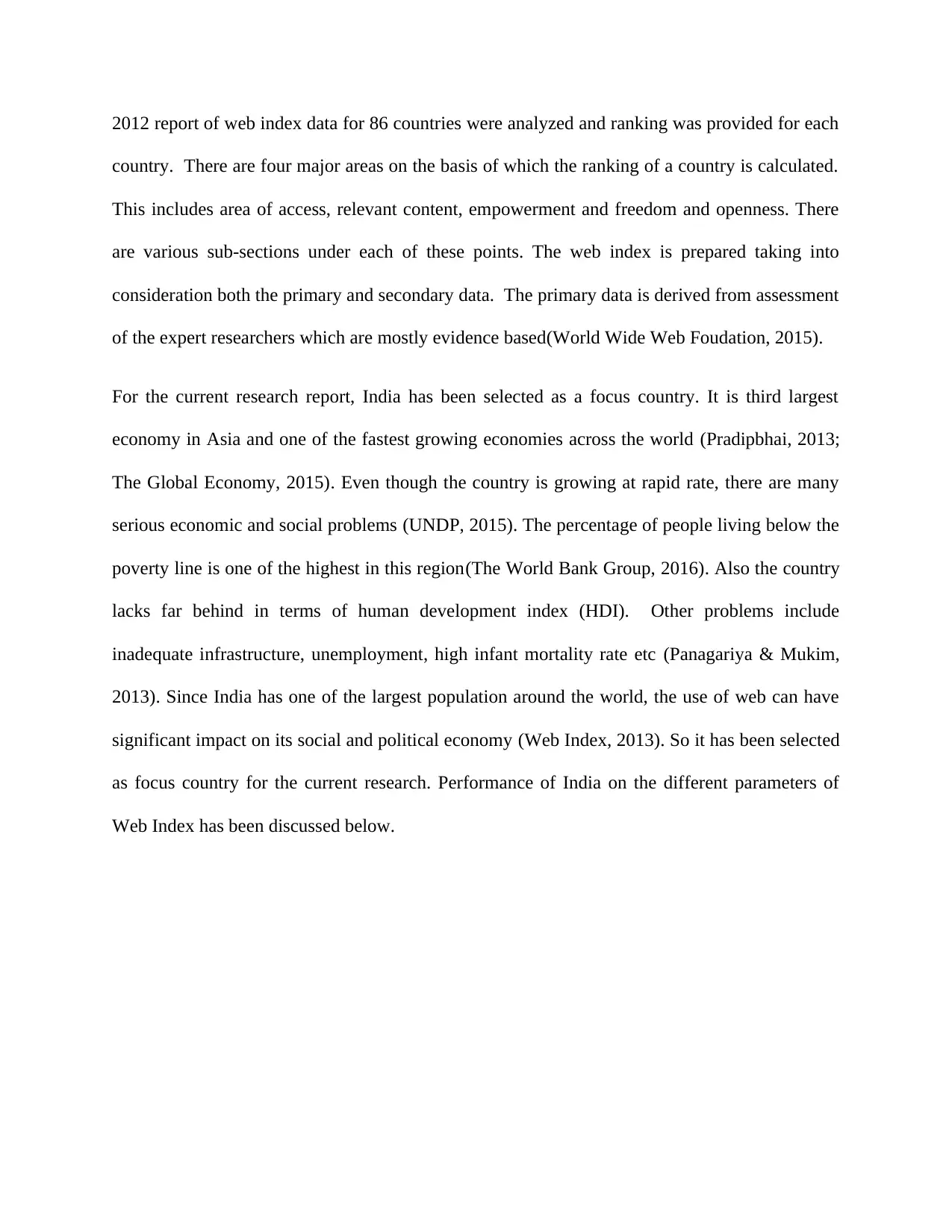
2012 report of web index data for 86 countries were analyzed and ranking was provided for each
country. There are four major areas on the basis of which the ranking of a country is calculated.
This includes area of access, relevant content, empowerment and freedom and openness. There
are various sub-sections under each of these points. The web index is prepared taking into
consideration both the primary and secondary data. The primary data is derived from assessment
of the expert researchers which are mostly evidence based(World Wide Web Foudation, 2015).
For the current research report, India has been selected as a focus country. It is third largest
economy in Asia and one of the fastest growing economies across the world (Pradipbhai, 2013;
The Global Economy, 2015). Even though the country is growing at rapid rate, there are many
serious economic and social problems (UNDP, 2015). The percentage of people living below the
poverty line is one of the highest in this region(The World Bank Group, 2016). Also the country
lacks far behind in terms of human development index (HDI). Other problems include
inadequate infrastructure, unemployment, high infant mortality rate etc (Panagariya & Mukim,
2013). Since India has one of the largest population around the world, the use of web can have
significant impact on its social and political economy (Web Index, 2013). So it has been selected
as focus country for the current research. Performance of India on the different parameters of
Web Index has been discussed below.
country. There are four major areas on the basis of which the ranking of a country is calculated.
This includes area of access, relevant content, empowerment and freedom and openness. There
are various sub-sections under each of these points. The web index is prepared taking into
consideration both the primary and secondary data. The primary data is derived from assessment
of the expert researchers which are mostly evidence based(World Wide Web Foudation, 2015).
For the current research report, India has been selected as a focus country. It is third largest
economy in Asia and one of the fastest growing economies across the world (Pradipbhai, 2013;
The Global Economy, 2015). Even though the country is growing at rapid rate, there are many
serious economic and social problems (UNDP, 2015). The percentage of people living below the
poverty line is one of the highest in this region(The World Bank Group, 2016). Also the country
lacks far behind in terms of human development index (HDI). Other problems include
inadequate infrastructure, unemployment, high infant mortality rate etc (Panagariya & Mukim,
2013). Since India has one of the largest population around the world, the use of web can have
significant impact on its social and political economy (Web Index, 2013). So it has been selected
as focus country for the current research. Performance of India on the different parameters of
Web Index has been discussed below.
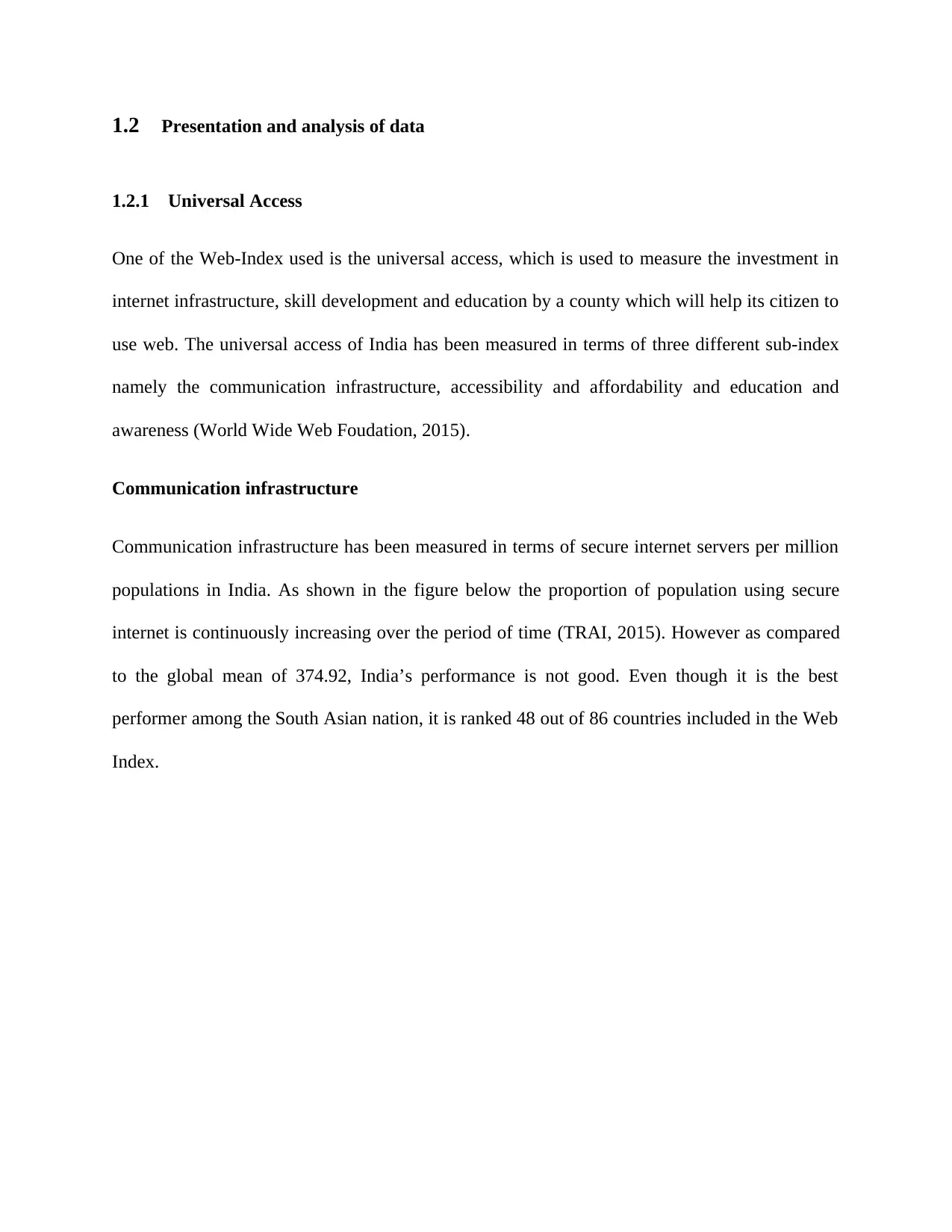
1.2 Presentation and analysis of data
1.2.1 Universal Access
One of the Web-Index used is the universal access, which is used to measure the investment in
internet infrastructure, skill development and education by a county which will help its citizen to
use web. The universal access of India has been measured in terms of three different sub-index
namely the communication infrastructure, accessibility and affordability and education and
awareness (World Wide Web Foudation, 2015).
Communication infrastructure
Communication infrastructure has been measured in terms of secure internet servers per million
populations in India. As shown in the figure below the proportion of population using secure
internet is continuously increasing over the period of time (TRAI, 2015). However as compared
to the global mean of 374.92, India’s performance is not good. Even though it is the best
performer among the South Asian nation, it is ranked 48 out of 86 countries included in the Web
Index.
1.2.1 Universal Access
One of the Web-Index used is the universal access, which is used to measure the investment in
internet infrastructure, skill development and education by a county which will help its citizen to
use web. The universal access of India has been measured in terms of three different sub-index
namely the communication infrastructure, accessibility and affordability and education and
awareness (World Wide Web Foudation, 2015).
Communication infrastructure
Communication infrastructure has been measured in terms of secure internet servers per million
populations in India. As shown in the figure below the proportion of population using secure
internet is continuously increasing over the period of time (TRAI, 2015). However as compared
to the global mean of 374.92, India’s performance is not good. Even though it is the best
performer among the South Asian nation, it is ranked 48 out of 86 countries included in the Web
Index.
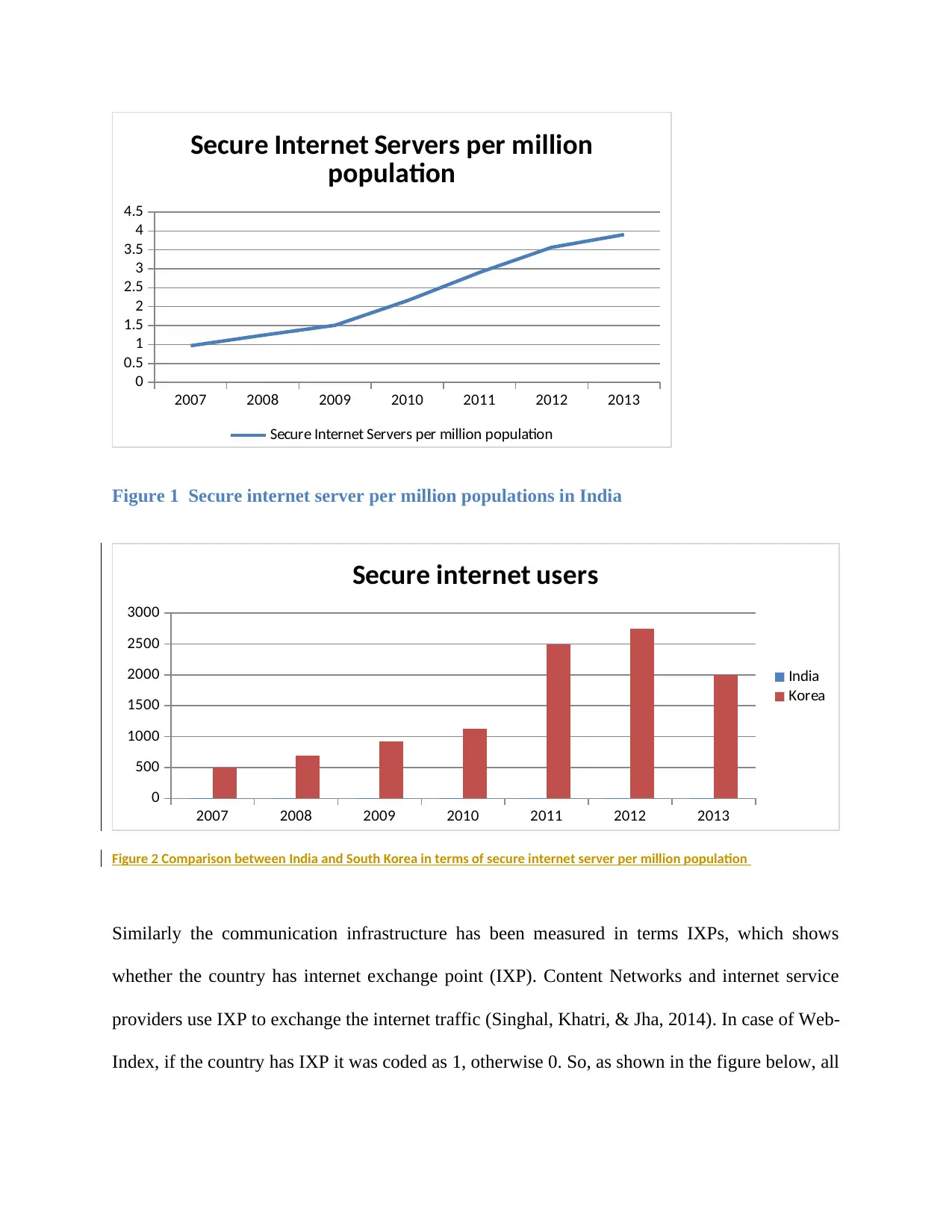
2007 2008 2009 2010 2011 2012 2013
0
0.5
1
1.5
2
2.5
3
3.5
4
4.5
Secure Internet Servers per million
population
Secure Internet Servers per million population
Figure 1 Secure internet server per million populations in India
2007 2008 2009 2010 2011 2012 2013
0
500
1000
1500
2000
2500
3000
Secure internet users
India
Korea
Figure 2 Comparison between India and South Korea in terms of secure internet server per million population
Similarly the communication infrastructure has been measured in terms IXPs, which shows
whether the country has internet exchange point (IXP). Content Networks and internet service
providers use IXP to exchange the internet traffic (Singhal, Khatri, & Jha, 2014). In case of Web-
Index, if the country has IXP it was coded as 1, otherwise 0. So, as shown in the figure below, all
0
0.5
1
1.5
2
2.5
3
3.5
4
4.5
Secure Internet Servers per million
population
Secure Internet Servers per million population
Figure 1 Secure internet server per million populations in India
2007 2008 2009 2010 2011 2012 2013
0
500
1000
1500
2000
2500
3000
Secure internet users
India
Korea
Figure 2 Comparison between India and South Korea in terms of secure internet server per million population
Similarly the communication infrastructure has been measured in terms IXPs, which shows
whether the country has internet exchange point (IXP). Content Networks and internet service
providers use IXP to exchange the internet traffic (Singhal, Khatri, & Jha, 2014). In case of Web-
Index, if the country has IXP it was coded as 1, otherwise 0. So, as shown in the figure below, all
Secure Best Marks with AI Grader
Need help grading? Try our AI Grader for instant feedback on your assignments.
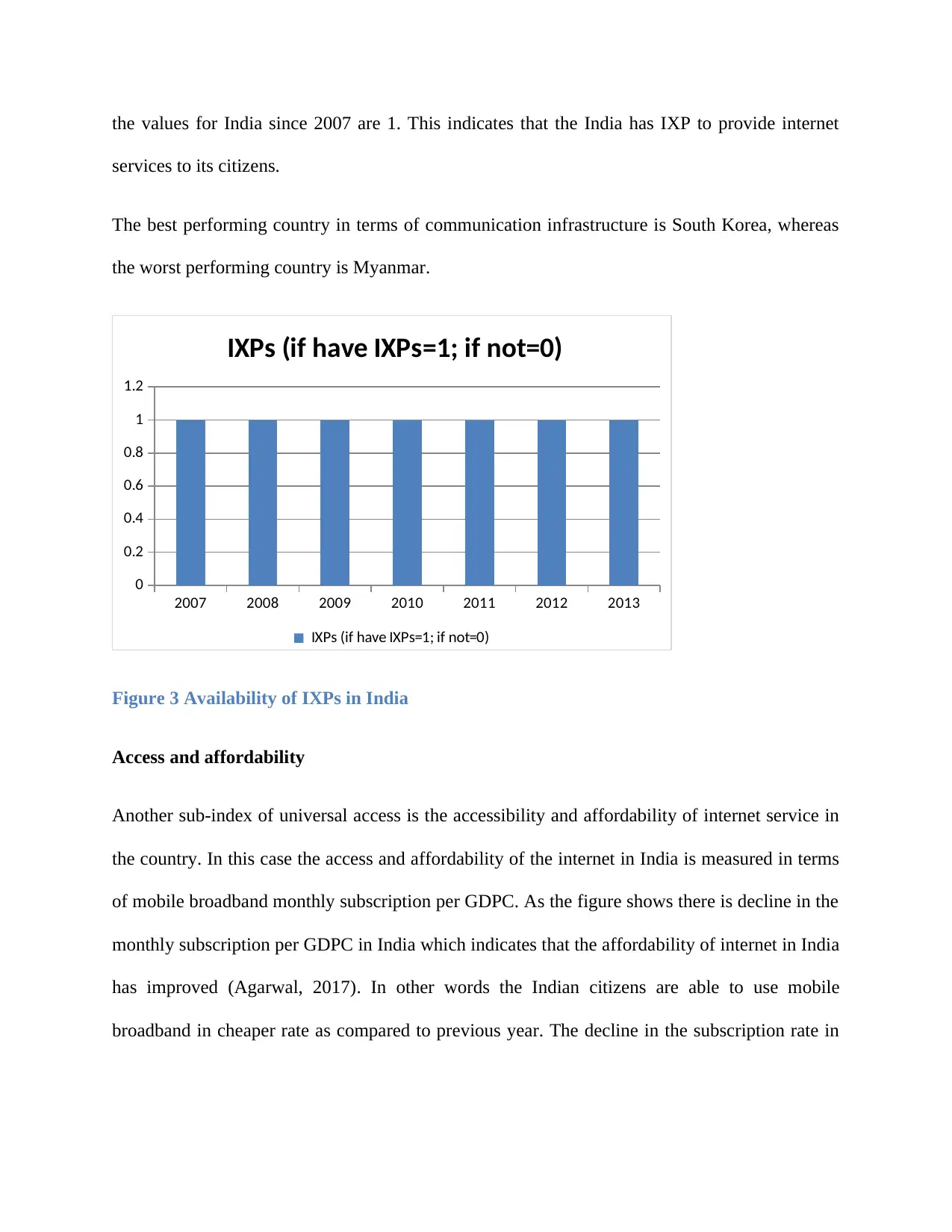
the values for India since 2007 are 1. This indicates that the India has IXP to provide internet
services to its citizens.
The best performing country in terms of communication infrastructure is South Korea, whereas
the worst performing country is Myanmar.
2007 2008 2009 2010 2011 2012 2013
0
0.2
0.4
0.6
0.8
1
1.2
IXPs (if have IXPs=1; if not=0)
IXPs (if have IXPs=1; if not=0)
Figure 3 Availability of IXPs in India
Access and affordability
Another sub-index of universal access is the accessibility and affordability of internet service in
the country. In this case the access and affordability of the internet in India is measured in terms
of mobile broadband monthly subscription per GDPC. As the figure shows there is decline in the
monthly subscription per GDPC in India which indicates that the affordability of internet in India
has improved (Agarwal, 2017). In other words the Indian citizens are able to use mobile
broadband in cheaper rate as compared to previous year. The decline in the subscription rate in
services to its citizens.
The best performing country in terms of communication infrastructure is South Korea, whereas
the worst performing country is Myanmar.
2007 2008 2009 2010 2011 2012 2013
0
0.2
0.4
0.6
0.8
1
1.2
IXPs (if have IXPs=1; if not=0)
IXPs (if have IXPs=1; if not=0)
Figure 3 Availability of IXPs in India
Access and affordability
Another sub-index of universal access is the accessibility and affordability of internet service in
the country. In this case the access and affordability of the internet in India is measured in terms
of mobile broadband monthly subscription per GDPC. As the figure shows there is decline in the
monthly subscription per GDPC in India which indicates that the affordability of internet in India
has improved (Agarwal, 2017). In other words the Indian citizens are able to use mobile
broadband in cheaper rate as compared to previous year. The decline in the subscription rate in
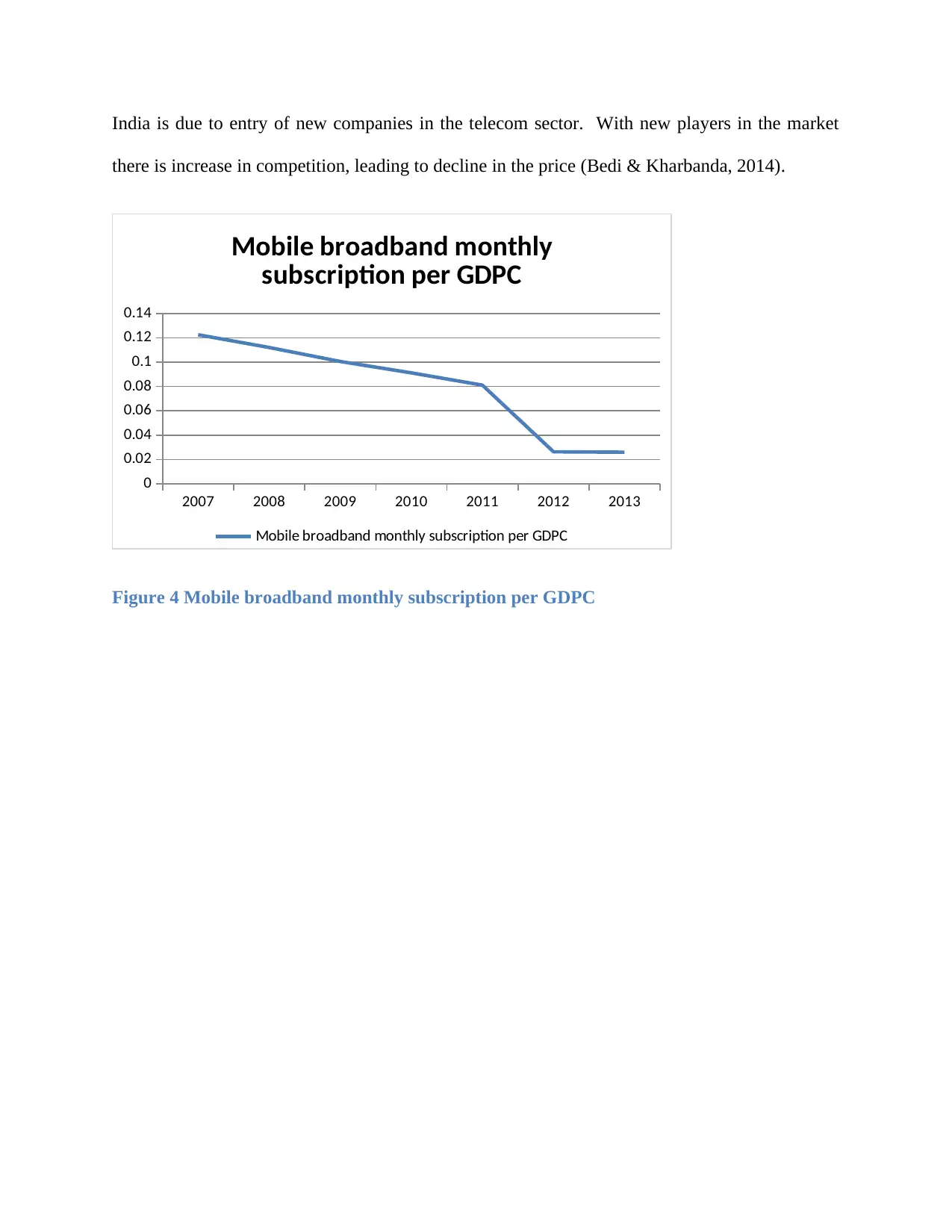
India is due to entry of new companies in the telecom sector. With new players in the market
there is increase in competition, leading to decline in the price (Bedi & Kharbanda, 2014).
2007 2008 2009 2010 2011 2012 2013
0
0.02
0.04
0.06
0.08
0.1
0.12
0.14
Mobile broadband monthly
subscription per GDPC
Mobile broadband monthly subscription per GDPC
Figure 4 Mobile broadband monthly subscription per GDPC
there is increase in competition, leading to decline in the price (Bedi & Kharbanda, 2014).
2007 2008 2009 2010 2011 2012 2013
0
0.02
0.04
0.06
0.08
0.1
0.12
0.14
Mobile broadband monthly
subscription per GDPC
Mobile broadband monthly subscription per GDPC
Figure 4 Mobile broadband monthly subscription per GDPC
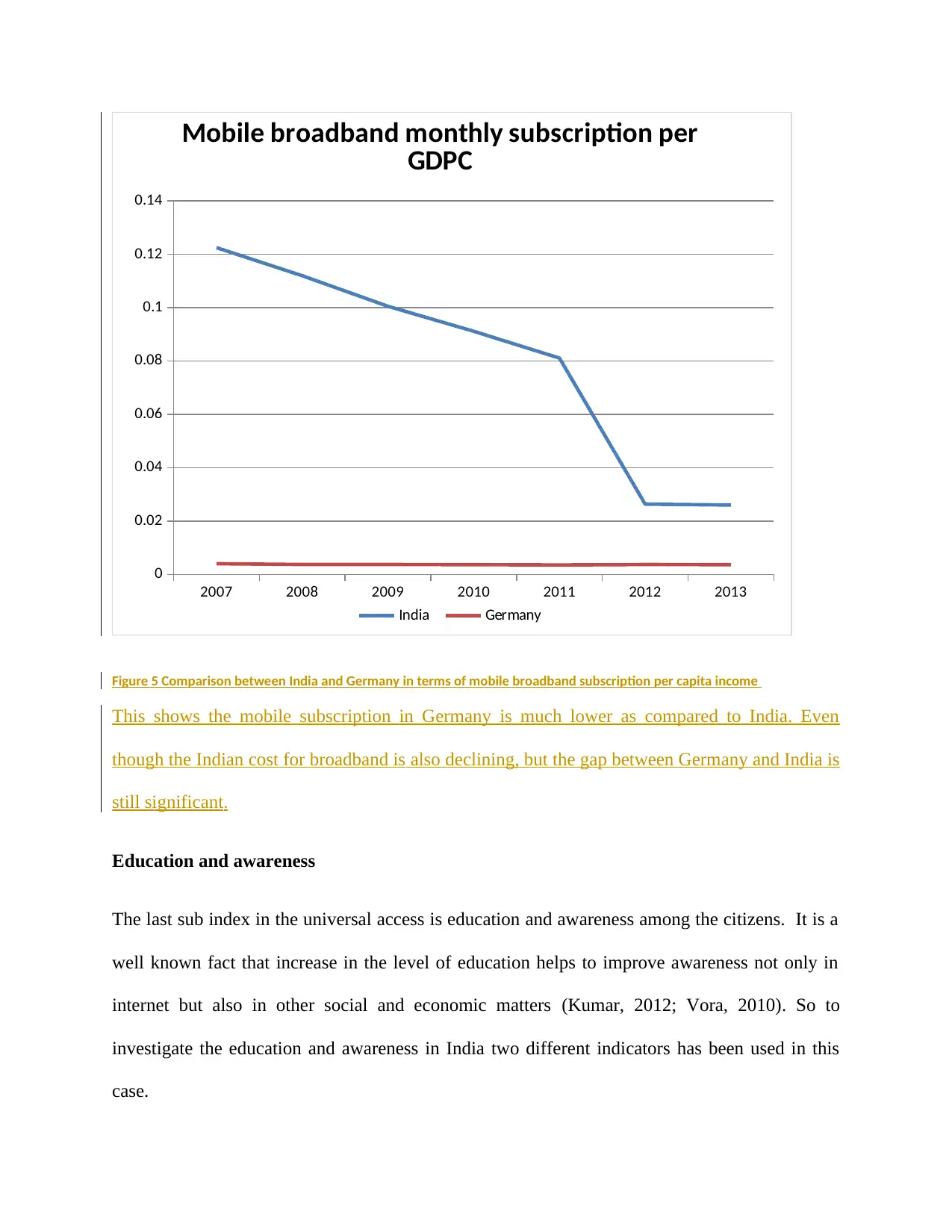
2007 2008 2009 2010 2011 2012 2013
0
0.02
0.04
0.06
0.08
0.1
0.12
0.14
Mobile broadband monthly subscription per
GDPC
India Germany
Figure 5 Comparison between India and Germany in terms of mobile broadband subscription per capita income
This shows the mobile subscription in Germany is much lower as compared to India. Even
though the Indian cost for broadband is also declining, but the gap between Germany and India is
still significant.
Education and awareness
The last sub index in the universal access is education and awareness among the citizens. It is a
well known fact that increase in the level of education helps to improve awareness not only in
internet but also in other social and economic matters (Kumar, 2012; Vora, 2010). So to
investigate the education and awareness in India two different indicators has been used in this
case.
0
0.02
0.04
0.06
0.08
0.1
0.12
0.14
Mobile broadband monthly subscription per
GDPC
India Germany
Figure 5 Comparison between India and Germany in terms of mobile broadband subscription per capita income
This shows the mobile subscription in Germany is much lower as compared to India. Even
though the Indian cost for broadband is also declining, but the gap between Germany and India is
still significant.
Education and awareness
The last sub index in the universal access is education and awareness among the citizens. It is a
well known fact that increase in the level of education helps to improve awareness not only in
internet but also in other social and economic matters (Kumar, 2012; Vora, 2010). So to
investigate the education and awareness in India two different indicators has been used in this
case.
Paraphrase This Document
Need a fresh take? Get an instant paraphrase of this document with our AI Paraphraser
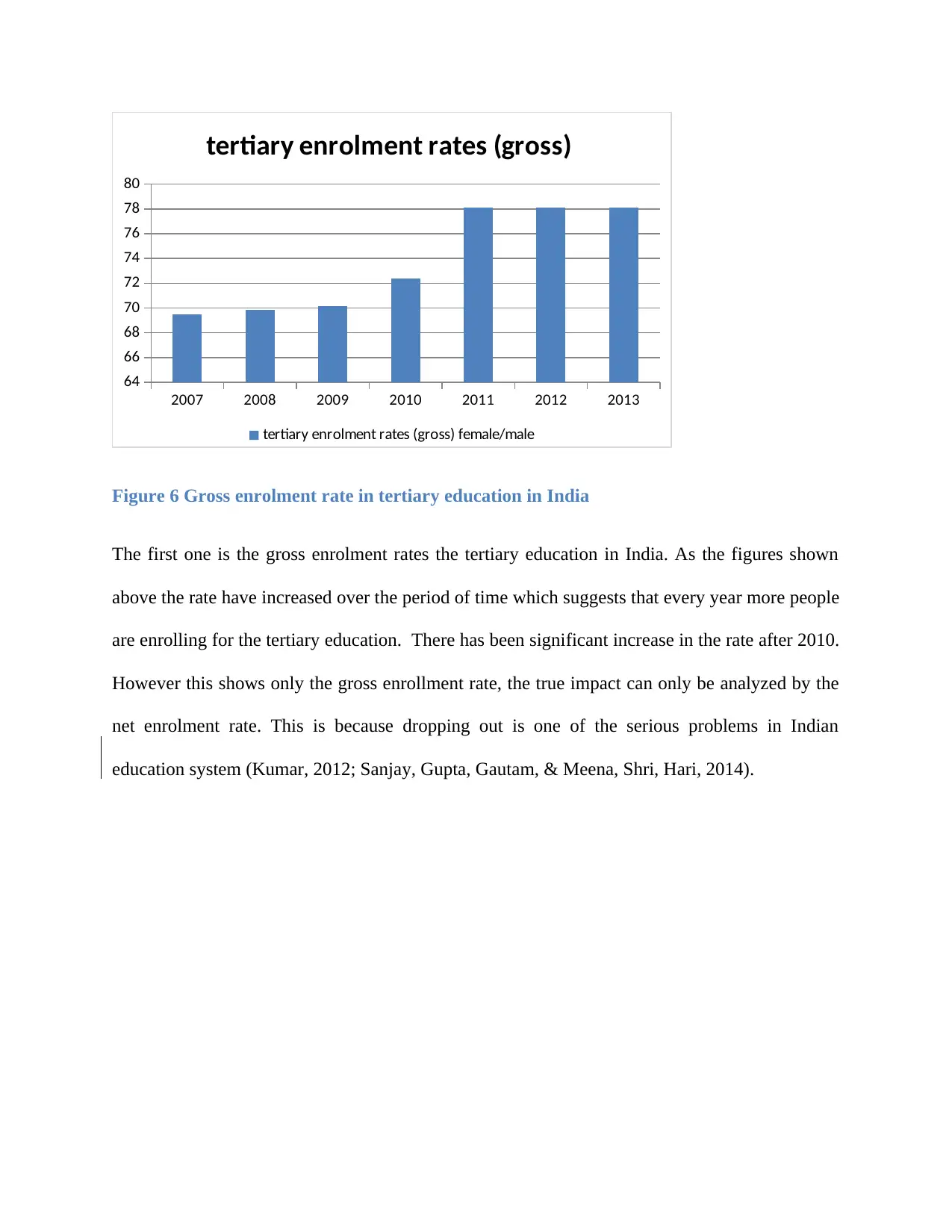
2007 2008 2009 2010 2011 2012 2013
64
66
68
70
72
74
76
78
80
tertiary enrolment rates (gross)
tertiary enrolment rates (gross) female/male
Figure 6 Gross enrolment rate in tertiary education in India
The first one is the gross enrolment rates the tertiary education in India. As the figures shown
above the rate have increased over the period of time which suggests that every year more people
are enrolling for the tertiary education. There has been significant increase in the rate after 2010.
However this shows only the gross enrollment rate, the true impact can only be analyzed by the
net enrolment rate. This is because dropping out is one of the serious problems in Indian
education system (Kumar, 2012; Sanjay, Gupta, Gautam, & Meena, Shri, Hari, 2014).
64
66
68
70
72
74
76
78
80
tertiary enrolment rates (gross)
tertiary enrolment rates (gross) female/male
Figure 6 Gross enrolment rate in tertiary education in India
The first one is the gross enrolment rates the tertiary education in India. As the figures shown
above the rate have increased over the period of time which suggests that every year more people
are enrolling for the tertiary education. There has been significant increase in the rate after 2010.
However this shows only the gross enrollment rate, the true impact can only be analyzed by the
net enrolment rate. This is because dropping out is one of the serious problems in Indian
education system (Kumar, 2012; Sanjay, Gupta, Gautam, & Meena, Shri, Hari, 2014).
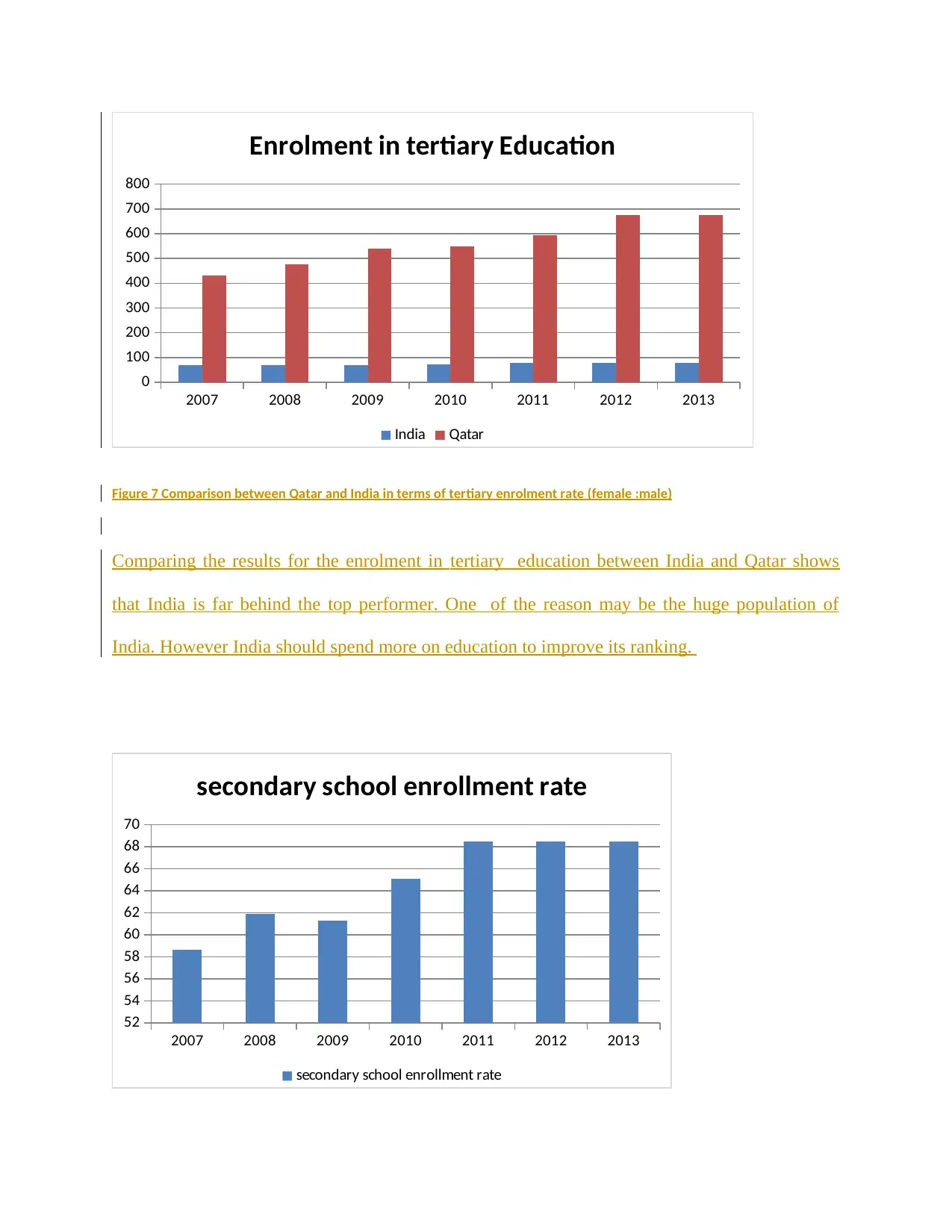
2007 2008 2009 2010 2011 2012 2013
0
100
200
300
400
500
600
700
800
Enrolment in tertiary Education
India Qatar
Figure 7 Comparison between Qatar and India in terms of tertiary enrolment rate (female :male)
Comparing the results for the enrolment in tertiary education between India and Qatar shows
that India is far behind the top performer. One of the reason may be the huge population of
India. However India should spend more on education to improve its ranking.
2007 2008 2009 2010 2011 2012 2013
52
54
56
58
60
62
64
66
68
70
secondary school enrollment rate
secondary school enrollment rate
0
100
200
300
400
500
600
700
800
Enrolment in tertiary Education
India Qatar
Figure 7 Comparison between Qatar and India in terms of tertiary enrolment rate (female :male)
Comparing the results for the enrolment in tertiary education between India and Qatar shows
that India is far behind the top performer. One of the reason may be the huge population of
India. However India should spend more on education to improve its ranking.
2007 2008 2009 2010 2011 2012 2013
52
54
56
58
60
62
64
66
68
70
secondary school enrollment rate
secondary school enrollment rate
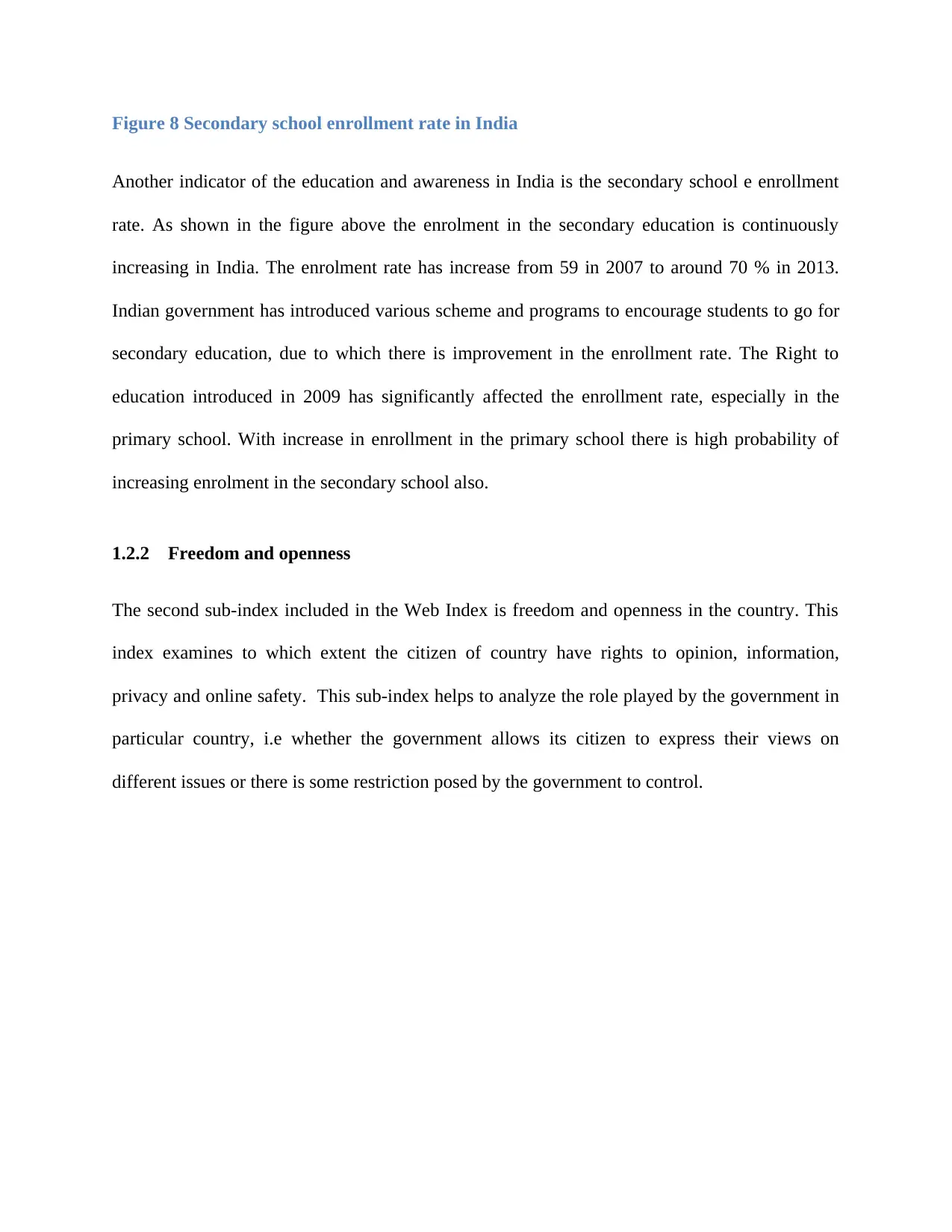
Figure 8 Secondary school enrollment rate in India
Another indicator of the education and awareness in India is the secondary school e enrollment
rate. As shown in the figure above the enrolment in the secondary education is continuously
increasing in India. The enrolment rate has increase from 59 in 2007 to around 70 % in 2013.
Indian government has introduced various scheme and programs to encourage students to go for
secondary education, due to which there is improvement in the enrollment rate. The Right to
education introduced in 2009 has significantly affected the enrollment rate, especially in the
primary school. With increase in enrollment in the primary school there is high probability of
increasing enrolment in the secondary school also.
1.2.2 Freedom and openness
The second sub-index included in the Web Index is freedom and openness in the country. This
index examines to which extent the citizen of country have rights to opinion, information,
privacy and online safety. This sub-index helps to analyze the role played by the government in
particular country, i.e whether the government allows its citizen to express their views on
different issues or there is some restriction posed by the government to control.
Another indicator of the education and awareness in India is the secondary school e enrollment
rate. As shown in the figure above the enrolment in the secondary education is continuously
increasing in India. The enrolment rate has increase from 59 in 2007 to around 70 % in 2013.
Indian government has introduced various scheme and programs to encourage students to go for
secondary education, due to which there is improvement in the enrollment rate. The Right to
education introduced in 2009 has significantly affected the enrollment rate, especially in the
primary school. With increase in enrollment in the primary school there is high probability of
increasing enrolment in the secondary school also.
1.2.2 Freedom and openness
The second sub-index included in the Web Index is freedom and openness in the country. This
index examines to which extent the citizen of country have rights to opinion, information,
privacy and online safety. This sub-index helps to analyze the role played by the government in
particular country, i.e whether the government allows its citizen to express their views on
different issues or there is some restriction posed by the government to control.
Secure Best Marks with AI Grader
Need help grading? Try our AI Grader for instant feedback on your assignments.
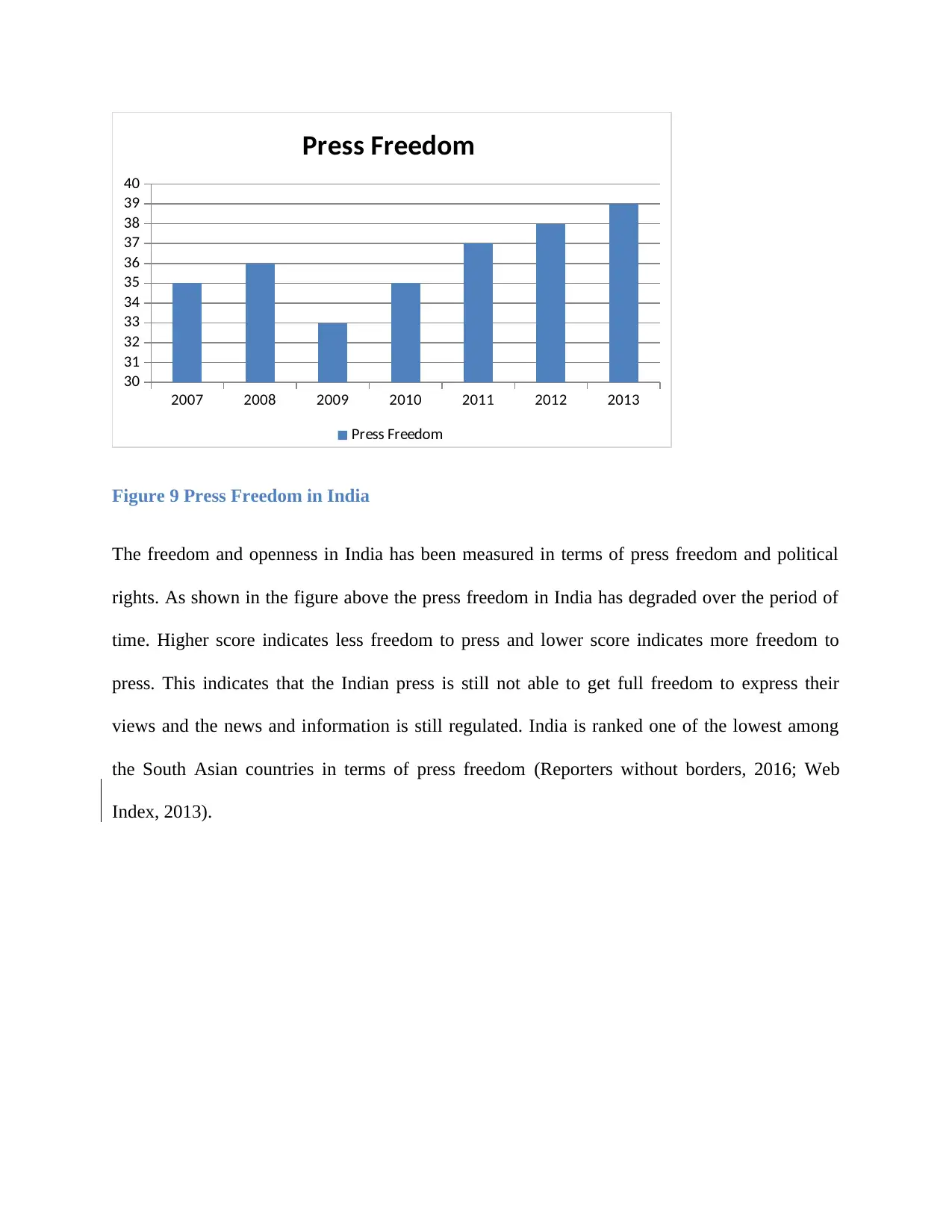
2007 2008 2009 2010 2011 2012 2013
30
31
32
33
34
35
36
37
38
39
40
Press Freedom
Press Freedom
Figure 9 Press Freedom in India
The freedom and openness in India has been measured in terms of press freedom and political
rights. As shown in the figure above the press freedom in India has degraded over the period of
time. Higher score indicates less freedom to press and lower score indicates more freedom to
press. This indicates that the Indian press is still not able to get full freedom to express their
views and the news and information is still regulated. India is ranked one of the lowest among
the South Asian countries in terms of press freedom (Reporters without borders, 2016; Web
Index, 2013).
30
31
32
33
34
35
36
37
38
39
40
Press Freedom
Press Freedom
Figure 9 Press Freedom in India
The freedom and openness in India has been measured in terms of press freedom and political
rights. As shown in the figure above the press freedom in India has degraded over the period of
time. Higher score indicates less freedom to press and lower score indicates more freedom to
press. This indicates that the Indian press is still not able to get full freedom to express their
views and the news and information is still regulated. India is ranked one of the lowest among
the South Asian countries in terms of press freedom (Reporters without borders, 2016; Web
Index, 2013).

2007 2008 2009 2010 2011 2012 2013
-20
-10
0
10
20
30
40
50
Press Freedom
India Norway
Figure 10 Comparing press freedom in India and Norway
Lower the score better the press freedom in the country. So the results from the above graph
show that press freedom is much better in Norway as compared to India. In 2012 the press
freedom in Norway declines due to which the gap in the score decreases. However there is no
improvement in Indian press freedom.
2007 2008 2009 2010 2011 2012 2013
0
0.5
1
1.5
2
2.5
political rights
political rights
Figure 11 Political rights in India
-20
-10
0
10
20
30
40
50
Press Freedom
India Norway
Figure 10 Comparing press freedom in India and Norway
Lower the score better the press freedom in the country. So the results from the above graph
show that press freedom is much better in Norway as compared to India. In 2012 the press
freedom in Norway declines due to which the gap in the score decreases. However there is no
improvement in Indian press freedom.
2007 2008 2009 2010 2011 2012 2013
0
0.5
1
1.5
2
2.5
political rights
political rights
Figure 11 Political rights in India
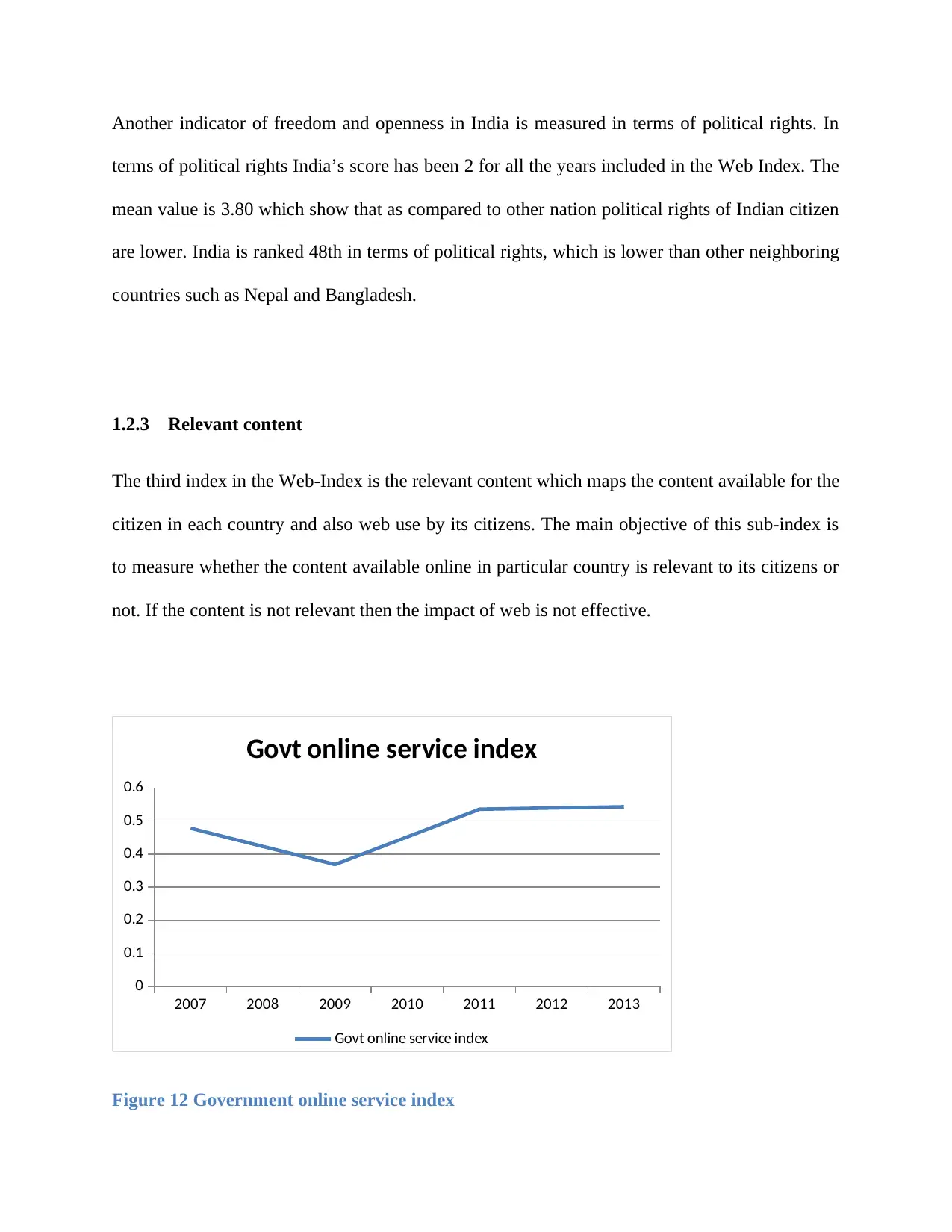
Another indicator of freedom and openness in India is measured in terms of political rights. In
terms of political rights India’s score has been 2 for all the years included in the Web Index. The
mean value is 3.80 which show that as compared to other nation political rights of Indian citizen
are lower. India is ranked 48th in terms of political rights, which is lower than other neighboring
countries such as Nepal and Bangladesh.
1.2.3 Relevant content
The third index in the Web-Index is the relevant content which maps the content available for the
citizen in each country and also web use by its citizens. The main objective of this sub-index is
to measure whether the content available online in particular country is relevant to its citizens or
not. If the content is not relevant then the impact of web is not effective.
2007 2008 2009 2010 2011 2012 2013
0
0.1
0.2
0.3
0.4
0.5
0.6
Govt online service index
Govt online service index
Figure 12 Government online service index
terms of political rights India’s score has been 2 for all the years included in the Web Index. The
mean value is 3.80 which show that as compared to other nation political rights of Indian citizen
are lower. India is ranked 48th in terms of political rights, which is lower than other neighboring
countries such as Nepal and Bangladesh.
1.2.3 Relevant content
The third index in the Web-Index is the relevant content which maps the content available for the
citizen in each country and also web use by its citizens. The main objective of this sub-index is
to measure whether the content available online in particular country is relevant to its citizens or
not. If the content is not relevant then the impact of web is not effective.
2007 2008 2009 2010 2011 2012 2013
0
0.1
0.2
0.3
0.4
0.5
0.6
Govt online service index
Govt online service index
Figure 12 Government online service index
Paraphrase This Document
Need a fresh take? Get an instant paraphrase of this document with our AI Paraphraser
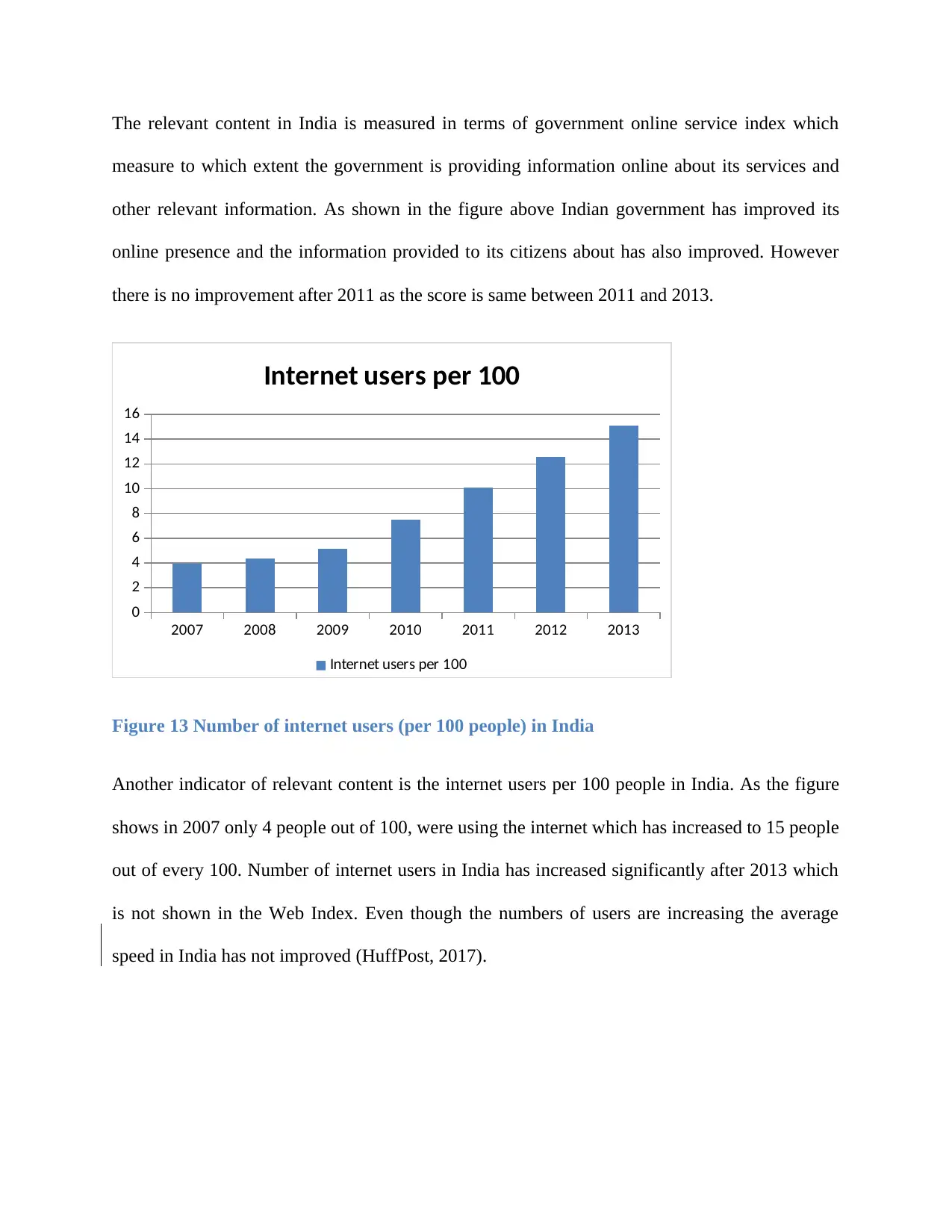
The relevant content in India is measured in terms of government online service index which
measure to which extent the government is providing information online about its services and
other relevant information. As shown in the figure above Indian government has improved its
online presence and the information provided to its citizens about has also improved. However
there is no improvement after 2011 as the score is same between 2011 and 2013.
2007 2008 2009 2010 2011 2012 2013
0
2
4
6
8
10
12
14
16
Internet users per 100
Internet users per 100
Figure 13 Number of internet users (per 100 people) in India
Another indicator of relevant content is the internet users per 100 people in India. As the figure
shows in 2007 only 4 people out of 100, were using the internet which has increased to 15 people
out of every 100. Number of internet users in India has increased significantly after 2013 which
is not shown in the Web Index. Even though the numbers of users are increasing the average
speed in India has not improved (HuffPost, 2017).
measure to which extent the government is providing information online about its services and
other relevant information. As shown in the figure above Indian government has improved its
online presence and the information provided to its citizens about has also improved. However
there is no improvement after 2011 as the score is same between 2011 and 2013.
2007 2008 2009 2010 2011 2012 2013
0
2
4
6
8
10
12
14
16
Internet users per 100
Internet users per 100
Figure 13 Number of internet users (per 100 people) in India
Another indicator of relevant content is the internet users per 100 people in India. As the figure
shows in 2007 only 4 people out of 100, were using the internet which has increased to 15 people
out of every 100. Number of internet users in India has increased significantly after 2013 which
is not shown in the Web Index. Even though the numbers of users are increasing the average
speed in India has not improved (HuffPost, 2017).
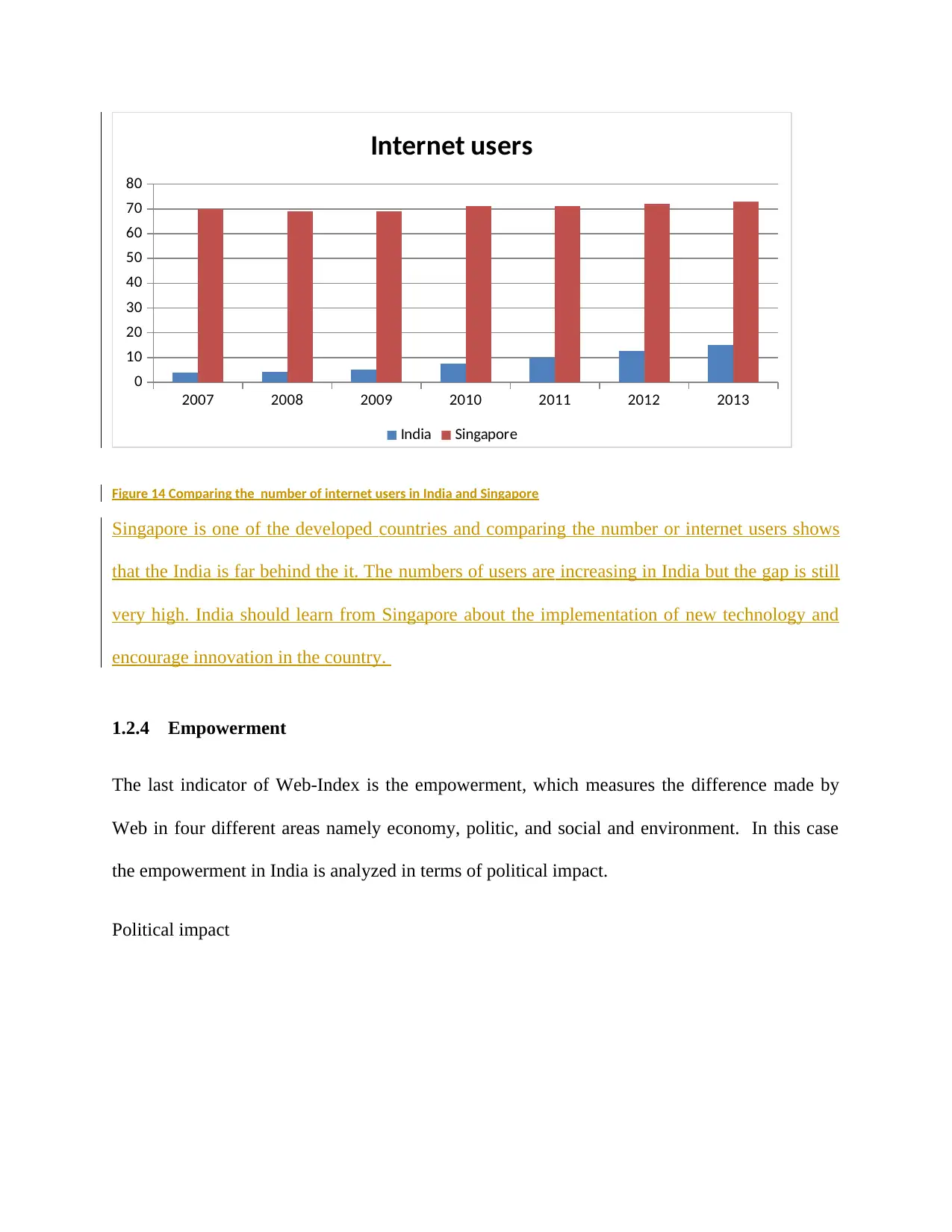
2007 2008 2009 2010 2011 2012 2013
0
10
20
30
40
50
60
70
80
Internet users
India Singapore
Figure 14 Comparing the number of internet users in India and Singapore
Singapore is one of the developed countries and comparing the number or internet users shows
that the India is far behind the it. The numbers of users are increasing in India but the gap is still
very high. India should learn from Singapore about the implementation of new technology and
encourage innovation in the country.
1.2.4 Empowerment
The last indicator of Web-Index is the empowerment, which measures the difference made by
Web in four different areas namely economy, politic, and social and environment. In this case
the empowerment in India is analyzed in terms of political impact.
Political impact
0
10
20
30
40
50
60
70
80
Internet users
India Singapore
Figure 14 Comparing the number of internet users in India and Singapore
Singapore is one of the developed countries and comparing the number or internet users shows
that the India is far behind the it. The numbers of users are increasing in India but the gap is still
very high. India should learn from Singapore about the implementation of new technology and
encourage innovation in the country.
1.2.4 Empowerment
The last indicator of Web-Index is the empowerment, which measures the difference made by
Web in four different areas namely economy, politic, and social and environment. In this case
the empowerment in India is analyzed in terms of political impact.
Political impact

2007 2008 2009 2010 2011 2012 2013
0
0.1
0.2
0.3
0.4
0.5
0.6
0.7
E-participation index
E-participation index
Figure 15 E participation index in India
The E-participation index has been used as the indicator of political impact in India. E
participation is used to measure the extent of use of services provided online by the government
to its citizens and also the interaction between different stakeholders in the decision making
process. As shown in the figure above the E participation index of India has increased
significantly after 2011.
2007 2008 2009 2010 2011 2012 2013
0
0.1
0.2
0.3
0.4
0.5
0.6
0.7
0.8
0.9
1
E participation Index
India Singapore
0
0.1
0.2
0.3
0.4
0.5
0.6
0.7
E-participation index
E-participation index
Figure 15 E participation index in India
The E-participation index has been used as the indicator of political impact in India. E
participation is used to measure the extent of use of services provided online by the government
to its citizens and also the interaction between different stakeholders in the decision making
process. As shown in the figure above the E participation index of India has increased
significantly after 2011.
2007 2008 2009 2010 2011 2012 2013
0
0.1
0.2
0.3
0.4
0.5
0.6
0.7
0.8
0.9
1
E participation Index
India Singapore
Secure Best Marks with AI Grader
Need help grading? Try our AI Grader for instant feedback on your assignments.
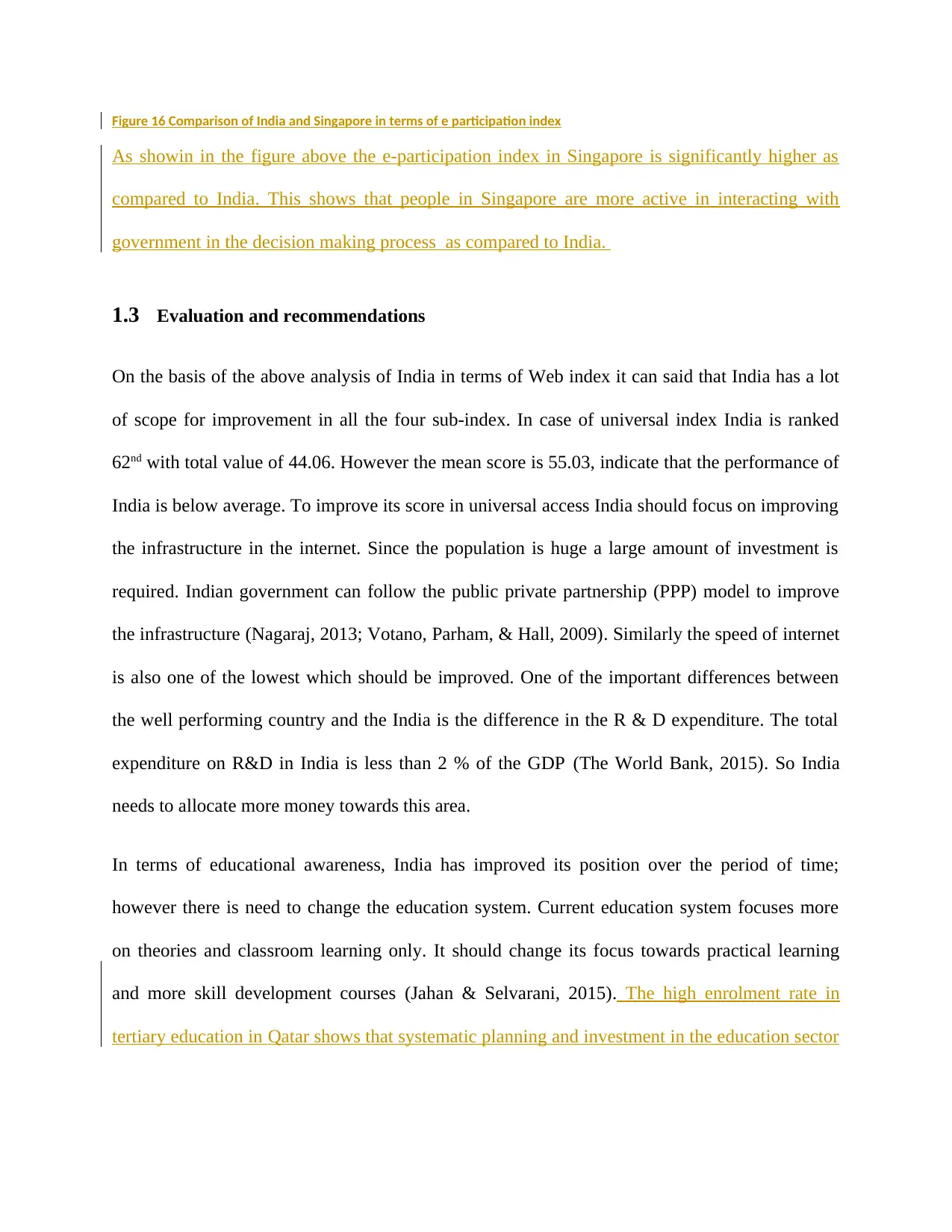
Figure 16 Comparison of India and Singapore in terms of e participation index
As showin in the figure above the e-participation index in Singapore is significantly higher as
compared to India. This shows that people in Singapore are more active in interacting with
government in the decision making process as compared to India.
1.3 Evaluation and recommendations
On the basis of the above analysis of India in terms of Web index it can said that India has a lot
of scope for improvement in all the four sub-index. In case of universal index India is ranked
62nd with total value of 44.06. However the mean score is 55.03, indicate that the performance of
India is below average. To improve its score in universal access India should focus on improving
the infrastructure in the internet. Since the population is huge a large amount of investment is
required. Indian government can follow the public private partnership (PPP) model to improve
the infrastructure (Nagaraj, 2013; Votano, Parham, & Hall, 2009). Similarly the speed of internet
is also one of the lowest which should be improved. One of the important differences between
the well performing country and the India is the difference in the R & D expenditure. The total
expenditure on R&D in India is less than 2 % of the GDP (The World Bank, 2015). So India
needs to allocate more money towards this area.
In terms of educational awareness, India has improved its position over the period of time;
however there is need to change the education system. Current education system focuses more
on theories and classroom learning only. It should change its focus towards practical learning
and more skill development courses (Jahan & Selvarani, 2015). The high enrolment rate in
tertiary education in Qatar shows that systematic planning and investment in the education sector
As showin in the figure above the e-participation index in Singapore is significantly higher as
compared to India. This shows that people in Singapore are more active in interacting with
government in the decision making process as compared to India.
1.3 Evaluation and recommendations
On the basis of the above analysis of India in terms of Web index it can said that India has a lot
of scope for improvement in all the four sub-index. In case of universal index India is ranked
62nd with total value of 44.06. However the mean score is 55.03, indicate that the performance of
India is below average. To improve its score in universal access India should focus on improving
the infrastructure in the internet. Since the population is huge a large amount of investment is
required. Indian government can follow the public private partnership (PPP) model to improve
the infrastructure (Nagaraj, 2013; Votano, Parham, & Hall, 2009). Similarly the speed of internet
is also one of the lowest which should be improved. One of the important differences between
the well performing country and the India is the difference in the R & D expenditure. The total
expenditure on R&D in India is less than 2 % of the GDP (The World Bank, 2015). So India
needs to allocate more money towards this area.
In terms of educational awareness, India has improved its position over the period of time;
however there is need to change the education system. Current education system focuses more
on theories and classroom learning only. It should change its focus towards practical learning
and more skill development courses (Jahan & Selvarani, 2015). The high enrolment rate in
tertiary education in Qatar shows that systematic planning and investment in the education sector
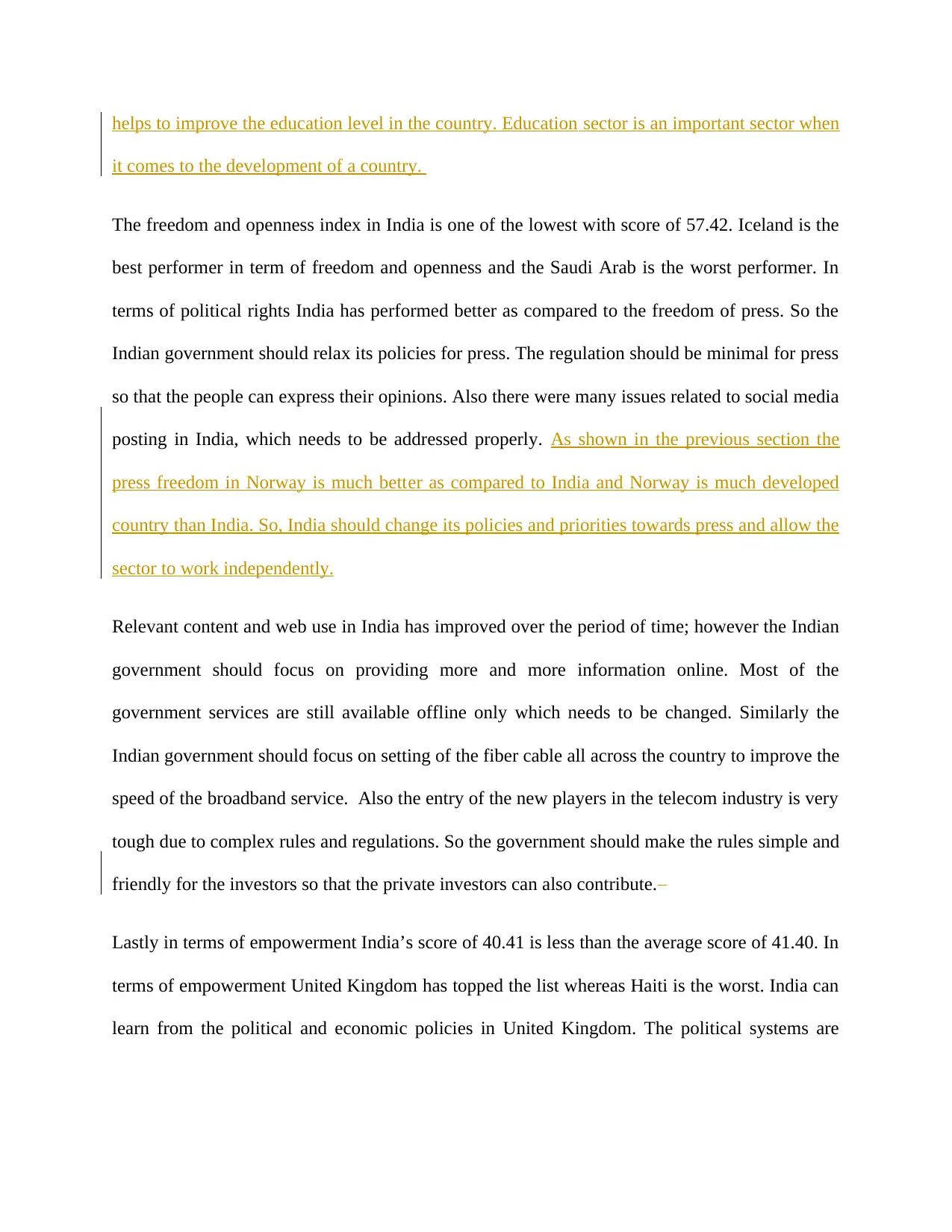
helps to improve the education level in the country. Education sector is an important sector when
it comes to the development of a country.
The freedom and openness index in India is one of the lowest with score of 57.42. Iceland is the
best performer in term of freedom and openness and the Saudi Arab is the worst performer. In
terms of political rights India has performed better as compared to the freedom of press. So the
Indian government should relax its policies for press. The regulation should be minimal for press
so that the people can express their opinions. Also there were many issues related to social media
posting in India, which needs to be addressed properly. As shown in the previous section the
press freedom in Norway is much better as compared to India and Norway is much developed
country than India. So, India should change its policies and priorities towards press and allow the
sector to work independently.
Relevant content and web use in India has improved over the period of time; however the Indian
government should focus on providing more and more information online. Most of the
government services are still available offline only which needs to be changed. Similarly the
Indian government should focus on setting of the fiber cable all across the country to improve the
speed of the broadband service. Also the entry of the new players in the telecom industry is very
tough due to complex rules and regulations. So the government should make the rules simple and
friendly for the investors so that the private investors can also contribute.
Lastly in terms of empowerment India’s score of 40.41 is less than the average score of 41.40. In
terms of empowerment United Kingdom has topped the list whereas Haiti is the worst. India can
learn from the political and economic policies in United Kingdom. The political systems are
it comes to the development of a country.
The freedom and openness index in India is one of the lowest with score of 57.42. Iceland is the
best performer in term of freedom and openness and the Saudi Arab is the worst performer. In
terms of political rights India has performed better as compared to the freedom of press. So the
Indian government should relax its policies for press. The regulation should be minimal for press
so that the people can express their opinions. Also there were many issues related to social media
posting in India, which needs to be addressed properly. As shown in the previous section the
press freedom in Norway is much better as compared to India and Norway is much developed
country than India. So, India should change its policies and priorities towards press and allow the
sector to work independently.
Relevant content and web use in India has improved over the period of time; however the Indian
government should focus on providing more and more information online. Most of the
government services are still available offline only which needs to be changed. Similarly the
Indian government should focus on setting of the fiber cable all across the country to improve the
speed of the broadband service. Also the entry of the new players in the telecom industry is very
tough due to complex rules and regulations. So the government should make the rules simple and
friendly for the investors so that the private investors can also contribute.
Lastly in terms of empowerment India’s score of 40.41 is less than the average score of 41.40. In
terms of empowerment United Kingdom has topped the list whereas Haiti is the worst. India can
learn from the political and economic policies in United Kingdom. The political systems are
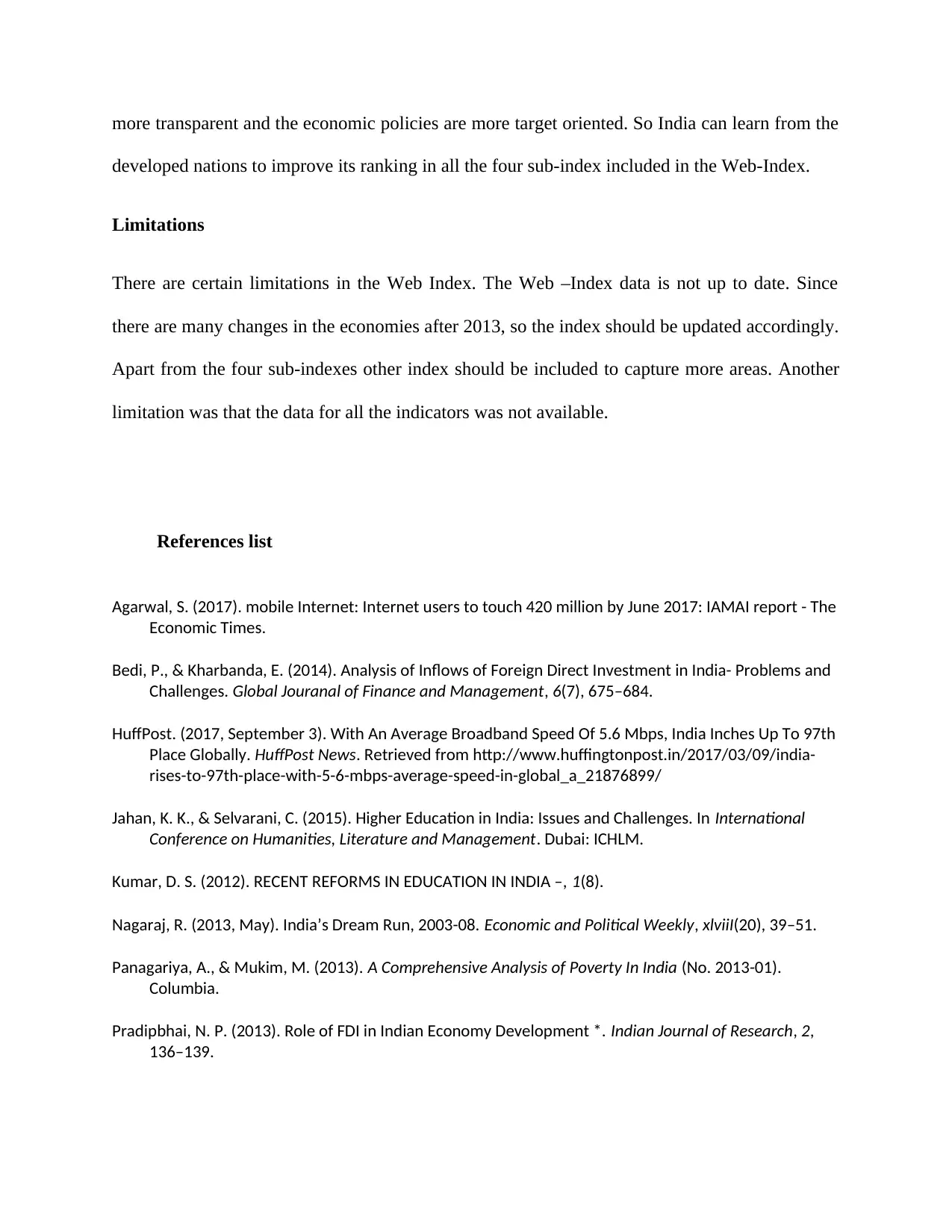
more transparent and the economic policies are more target oriented. So India can learn from the
developed nations to improve its ranking in all the four sub-index included in the Web-Index.
Limitations
There are certain limitations in the Web Index. The Web –Index data is not up to date. Since
there are many changes in the economies after 2013, so the index should be updated accordingly.
Apart from the four sub-indexes other index should be included to capture more areas. Another
limitation was that the data for all the indicators was not available.
References list
Agarwal, S. (2017). mobile Internet: Internet users to touch 420 million by June 2017: IAMAI report - The
Economic Times.
Bedi, P., & Kharbanda, E. (2014). Analysis of Inflows of Foreign Direct Investment in India- Problems and
Challenges. Global Jouranal of Finance and Management, 6(7), 675–684.
HuffPost. (2017, September 3). With An Average Broadband Speed Of 5.6 Mbps, India Inches Up To 97th
Place Globally. HuffPost News. Retrieved from http://www.huffingtonpost.in/2017/03/09/india-
rises-to-97th-place-with-5-6-mbps-average-speed-in-global_a_21876899/
Jahan, K. K., & Selvarani, C. (2015). Higher Education in India: Issues and Challenges. In International
Conference on Humanities, Literature and Management. Dubai: ICHLM.
Kumar, D. S. (2012). RECENT REFORMS IN EDUCATION IN INDIA –, 1(8).
Nagaraj, R. (2013, May). India’s Dream Run, 2003-08. Economic and Political Weekly, xlviiI(20), 39–51.
Panagariya, A., & Mukim, M. (2013). A Comprehensive Analysis of Poverty In India (No. 2013-01).
Columbia.
Pradipbhai, N. P. (2013). Role of FDI in Indian Economy Development *. Indian Journal of Research, 2,
136–139.
developed nations to improve its ranking in all the four sub-index included in the Web-Index.
Limitations
There are certain limitations in the Web Index. The Web –Index data is not up to date. Since
there are many changes in the economies after 2013, so the index should be updated accordingly.
Apart from the four sub-indexes other index should be included to capture more areas. Another
limitation was that the data for all the indicators was not available.
References list
Agarwal, S. (2017). mobile Internet: Internet users to touch 420 million by June 2017: IAMAI report - The
Economic Times.
Bedi, P., & Kharbanda, E. (2014). Analysis of Inflows of Foreign Direct Investment in India- Problems and
Challenges. Global Jouranal of Finance and Management, 6(7), 675–684.
HuffPost. (2017, September 3). With An Average Broadband Speed Of 5.6 Mbps, India Inches Up To 97th
Place Globally. HuffPost News. Retrieved from http://www.huffingtonpost.in/2017/03/09/india-
rises-to-97th-place-with-5-6-mbps-average-speed-in-global_a_21876899/
Jahan, K. K., & Selvarani, C. (2015). Higher Education in India: Issues and Challenges. In International
Conference on Humanities, Literature and Management. Dubai: ICHLM.
Kumar, D. S. (2012). RECENT REFORMS IN EDUCATION IN INDIA –, 1(8).
Nagaraj, R. (2013, May). India’s Dream Run, 2003-08. Economic and Political Weekly, xlviiI(20), 39–51.
Panagariya, A., & Mukim, M. (2013). A Comprehensive Analysis of Poverty In India (No. 2013-01).
Columbia.
Pradipbhai, N. P. (2013). Role of FDI in Indian Economy Development *. Indian Journal of Research, 2,
136–139.
Paraphrase This Document
Need a fresh take? Get an instant paraphrase of this document with our AI Paraphraser
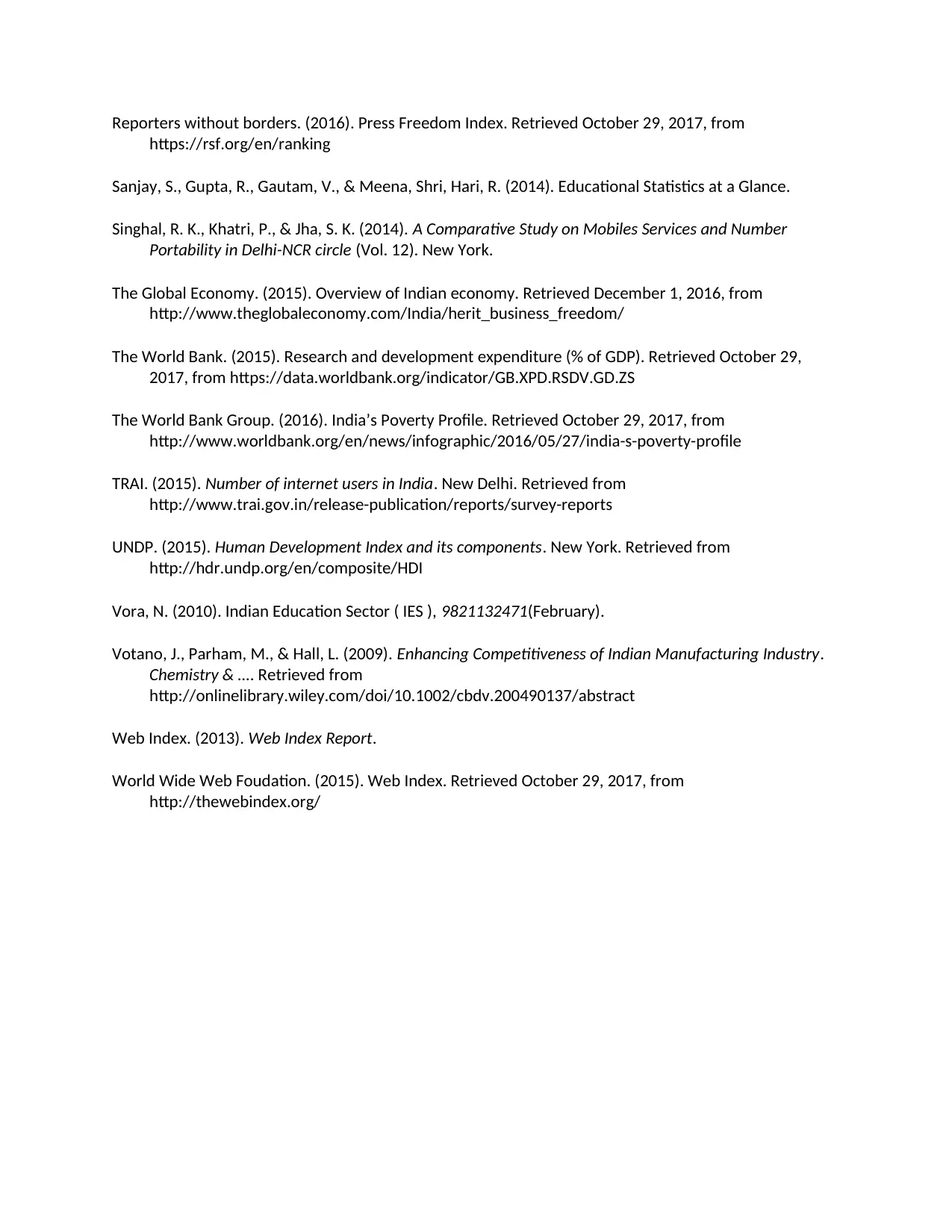
Reporters without borders. (2016). Press Freedom Index. Retrieved October 29, 2017, from
https://rsf.org/en/ranking
Sanjay, S., Gupta, R., Gautam, V., & Meena, Shri, Hari, R. (2014). Educational Statistics at a Glance.
Singhal, R. K., Khatri, P., & Jha, S. K. (2014). A Comparative Study on Mobiles Services and Number
Portability in Delhi-NCR circle (Vol. 12). New York.
The Global Economy. (2015). Overview of Indian economy. Retrieved December 1, 2016, from
http://www.theglobaleconomy.com/India/herit_business_freedom/
The World Bank. (2015). Research and development expenditure (% of GDP). Retrieved October 29,
2017, from https://data.worldbank.org/indicator/GB.XPD.RSDV.GD.ZS
The World Bank Group. (2016). India’s Poverty Profile. Retrieved October 29, 2017, from
http://www.worldbank.org/en/news/infographic/2016/05/27/india-s-poverty-profile
TRAI. (2015). Number of internet users in India. New Delhi. Retrieved from
http://www.trai.gov.in/release-publication/reports/survey-reports
UNDP. (2015). Human Development Index and its components. New York. Retrieved from
http://hdr.undp.org/en/composite/HDI
Vora, N. (2010). Indian Education Sector ( IES ), 9821132471(February).
Votano, J., Parham, M., & Hall, L. (2009). Enhancing Competitiveness of Indian Manufacturing Industry.
Chemistry & …. Retrieved from
http://onlinelibrary.wiley.com/doi/10.1002/cbdv.200490137/abstract
Web Index. (2013). Web Index Report.
World Wide Web Foudation. (2015). Web Index. Retrieved October 29, 2017, from
http://thewebindex.org/
https://rsf.org/en/ranking
Sanjay, S., Gupta, R., Gautam, V., & Meena, Shri, Hari, R. (2014). Educational Statistics at a Glance.
Singhal, R. K., Khatri, P., & Jha, S. K. (2014). A Comparative Study on Mobiles Services and Number
Portability in Delhi-NCR circle (Vol. 12). New York.
The Global Economy. (2015). Overview of Indian economy. Retrieved December 1, 2016, from
http://www.theglobaleconomy.com/India/herit_business_freedom/
The World Bank. (2015). Research and development expenditure (% of GDP). Retrieved October 29,
2017, from https://data.worldbank.org/indicator/GB.XPD.RSDV.GD.ZS
The World Bank Group. (2016). India’s Poverty Profile. Retrieved October 29, 2017, from
http://www.worldbank.org/en/news/infographic/2016/05/27/india-s-poverty-profile
TRAI. (2015). Number of internet users in India. New Delhi. Retrieved from
http://www.trai.gov.in/release-publication/reports/survey-reports
UNDP. (2015). Human Development Index and its components. New York. Retrieved from
http://hdr.undp.org/en/composite/HDI
Vora, N. (2010). Indian Education Sector ( IES ), 9821132471(February).
Votano, J., Parham, M., & Hall, L. (2009). Enhancing Competitiveness of Indian Manufacturing Industry.
Chemistry & …. Retrieved from
http://onlinelibrary.wiley.com/doi/10.1002/cbdv.200490137/abstract
Web Index. (2013). Web Index Report.
World Wide Web Foudation. (2015). Web Index. Retrieved October 29, 2017, from
http://thewebindex.org/
1 out of 20
Related Documents
Your All-in-One AI-Powered Toolkit for Academic Success.
+13062052269
info@desklib.com
Available 24*7 on WhatsApp / Email
![[object Object]](/_next/static/media/star-bottom.7253800d.svg)
Unlock your academic potential
© 2024 | Zucol Services PVT LTD | All rights reserved.





